A Culinary Tour of Berlin’s Most Vibrant
and Diverse Neighborhoods
Sampling Eclectic Foods by Bike
and on Foot
Article and photos by
Lies Ouwerkerk
Senior
Contributing Editor
1/2015

|
|
A
restaurant in a restored courtyard in Mitte,
a neighborhood in Berlin full of diverse places to
eat foods from many regions of the world.
|
Berlin, a city of about 3.5 million
inhabitants, is not only Germany’s capital, but also a multicultural
epicenter of arts and culture, boasting a large amount of
theaters, universities, museums, galleries, libraries, cinemas,
and other cultural venues.
Especially since the fall of the
Berlin Wall in 1989, the city became a magnet for many young
artists, musicians, and hipsters from all over the world,
settling into poor and cheap working class neighborhoods
as squatters and renters. With Berlin becoming more and
more a melting pot of different cultures, the interest in
certain types of food also underwent a radical change. While
Germany’s staples such as Schnitzel, Sauerbraten,
and Apfelkuche still dominated the culinary scene
in Berlin a few decades ago, thanks to the foreign influx,
increasing tourism, some innovative restaurateurs, and a
growing start-up scene, Berlin foodies have quickly caught
up with the rest of the world.
With only a couple of days to spend
in Berlin, I opt for exploring the city’s most vibrant and
diverse neighborhoods by bike and on foot, while simultaneously
checking out the kitchens. I sign up for a bicycle tour
to see many of Berlin’s architectural highlights — with
a lunch stop at a traditional Biergarten; a dinner
at the home of a designated Berliner host; and two walking
food tours, each with a different company and in a different
district. Beyond these organized tours, I also squeeze in
visits to food markets and specialty shops.
City Bike Tour
To find my bearings, I kick off my stay
in Berlin with the All-in-One City Bike Tour of "Fat
Tire Bike Tours," which starts at the TV tower on Alexander
Platz. A highly knowledgeable guide leads our group of 16
cyclists from all over the world along many of Berlin’s
must-see places such as the Reichstag (parliament building),
Museum Island, the recently finished Holocaust Memorial,
Checkpoint Charlie, the Brandenburg Gate, Hitler’s bunker,
and the last remaining sections of the Berlin Wall and watchtowers.
Two-thirds into the trip, we stop for
lunch at the traditional Biergarten Schleusenkrug,
located at the edge of the Zoo, to drink a pint of German
draft beer and devour a generous piece of grilled Bratwurst,
seated at huge communal tables beneath a canopy of lush
foliage.
"Fat Tire Bike Tours" also
organizes an evening food tour by bike through the Prenzlauer
Berg district, for a progressive 3-course sit-down meal
at three different stops. Bike rental is included in all
their tours.
Wine & Dine at a Berliner Host
Enjoying local hospitality in Berlin
is now at your fingertips, thanks to a new start-up called
"Open Doors Berlin." Ulrike Dettman, the brain
behind the idea, pairs me up with host Christine, a wine
blogger living on the 5h floor (no elevator) of a typical
former East Berlin building, in walking distance from my
AirBnB in Prenzlauer Berg.
Christine and I hit it off right away,
discover many common interests, and have lively conversations
over a delicious dinner that far exceeds my expectations.
Although "Open Doors Berlin" promises
a 3-course homemade meal, Christine conjures up a mouth-watering
5-course supper, including excellent wines. I am greeted
with an appetizer of thin dough with onions, pepper, and Ziegenkäse (goat
cheese), followed by Bärlauch (wild garlic) risotto,
lemon cornish hen with mushrooms, a dessert of rhubarb with
a müesli-butter mix and ice cream, and finally a caramelized
cheese with pistacho nuts, topped off with coffee and grappa.
A wonderful opportunity to dine in a real Berlin home, meet
with interesting hosts, hear stories about life in the capital,
and get lots of useful tips for the rest of your stay!
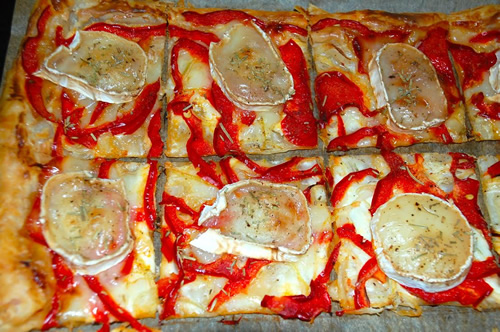
|
|
Appetizer, a tarte
with goat cheese on top, is just the beginning of
a very generous 5-course homemade meal at the home
of an "Open Door" with a native Berlin host.
|
Friedrichshain
For a walking food tour through the
former East Berlin district of Friedrichshain, the guide
of company "Eat the World" is meeting our group of six,
mainly German participants from other cities, at a meeting
point just off the Ubahn (metro) station on the monumental
Karl-Marx-Allee (formerly Stalin Allee, East Berlin’s flagship,
where not only annual parades showcasing the power and glory
of the communist government took place, but also the workers’
uprising against that government in 1953).
The guide is originally from Australia,
married a German, and has lived in Friedrichshain for over
20 years. All of which explains her thorough knowledge of
the history and development of this area from a typical
working class neighborhood into a largely gentrified quarter
with cafés, bistros, bars, flea markets, and specialty
shops lining the streets around Simon Dachstrasse, known
as the “Party Mile”.
For three hours, we are guided along
the most important historic and architectural sights, from
the Frankfurter Tor, via the residential streets where squatters
took over after the reunion of East and West, to Boxhagener
Platz with its lively flea market. And along the way, the
guide introduces us to at least seven different, carefully
selected culinary specialties which we eat on the go while
she tells her informative stories, or savor sitting down
in an Austrian café, a Polish bistro, a German snackbar,
a French café, and a truffle shop. Quality and variety are
excellent, and the amount of food is more than enough to
replace a full lunch. "Eat the World" also conducts walking
food tours in the districts of Charlottenburg, Kreuzberg,
Schöneberg, and Prenzlauer Berg.
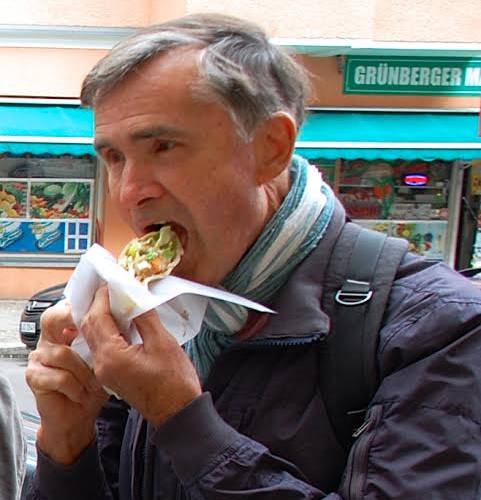
|
|
Sampling street
food in Friedrichshain.
|
Kreuzberg
From Friedrichshain, I cross the Spree
River, via the Oberbaumbrücken Bridge with its striking
towers, into the Kreuzberg district. This is an area known
for its street art, graffiti, and wall paintings (for instance
the open air East Side Gallery, the largest section of the
former Berlin wall, since 1990 serving as an international
memorial for freedom with over 100 paintings by artists
from all over the world). The neighborhood boasts factories
that have been reopened as artists’ workshops and galleries,
and the State Museum for Modern Art, Photography, and Architecture.
The artsy atmosphere of Kreuzberg can
also be felt at the Türkisches Markt am Maybachufer (Turkish Market), along
half a mile of the Landwehrkanal at the border of Kreuzberg
and Neuköln, where locals meet Berlin’s large Turkish immigrant
community each Tuesday and Friday between 11:00 a.m. and
6:30 p.m. to buy their fruits, vegetables, meats, breads,
olives, sweets, and Turkish food specialties like köfte and kebap.
A plethora of other articles such as woolen socks, colorful
fabrics, T-shirts, purses, shoes, flowers, and plants are
also on offer. Impromptu live concerts add extra liveliness
to all the sounds, smells, and colors of this true Oriental
Bazaar. In order to get rid of their fresh produce the same
day, vendors lower the already bargain prices even more
by late afternoon.
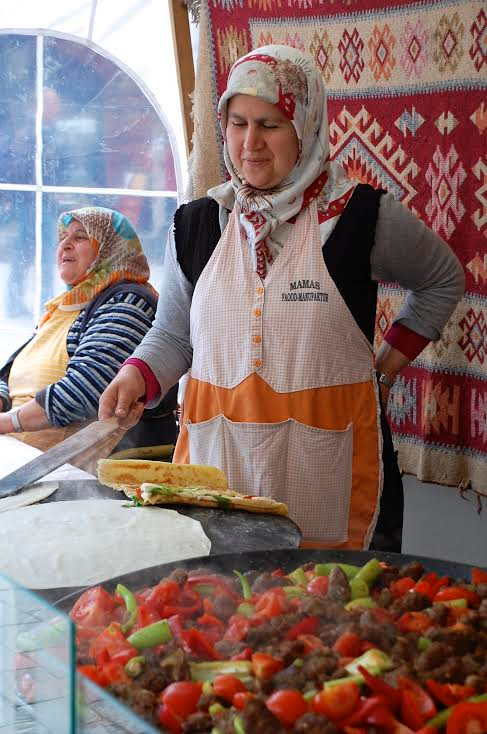
|
|
Women cooking at Türkenmarkt in
Neukölln/Kreuzberg.
|
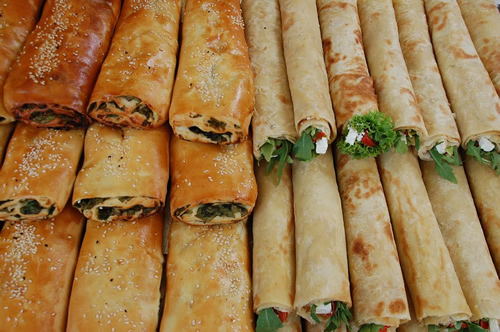
|
|
Türkenmarkt (Turkish
Market) in Neukölln/Kreuzberg, Berlin.
|
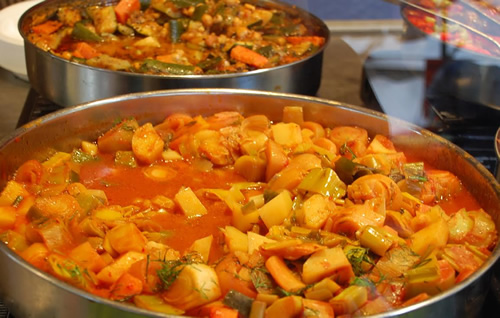
|
|
Stews cooking at Türkenmarkt in
Neukölln/Kreuzberg.
|
On Fridays and Saturdays, as well as
on Thursday “street food” nights, there is another worthwhile
market in Kreuzberg: Markthalle Neun (9). At this
bio-market, you can buy meat from farms that practice ethical
husbandry, and seafood from sustainable fisheries. The old
market building also houses a meat and fish smoke house,
a small in-house brewery, a cafeteria with a view of the
cooks at work, and a transparent bakery. On Thursday nights,
foodie fun is at its peak when stalls offer a kaleidoscope
of street foods and drinks, turning the market into a cozy
and informal gathering place. I spot pulled pork sandwiches,
original Taiwanese buns, Chilean empanadas, Hungarian goulash
rolls, sesame and green tea ice cream, gin fizz, a large
variety of wines, and German draft beer.
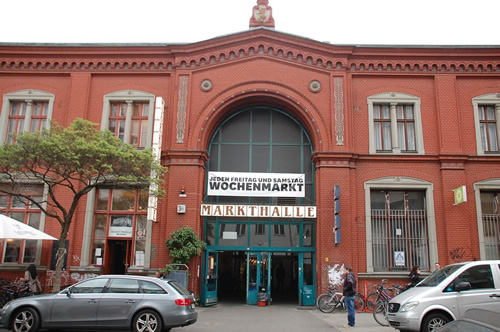
|
|
Markthalle 9
in Kreuzberg, where some days almost any type of food
and drink in the world seems available.
|
Mitte
The 3.5 hours walking tour with Bastian
Schwihal, founder of "Berlin Food Tours," through
the central Mitte district, with its old cobble stoned streets,
stately homes, courtyards, chic shops, street art, and galleries,
is another hit. With lots of energy, wit, and knowledge,
he guides our group of nine through the backstreets of Berlin’s
historic core towards his favorite food places, where we
indulge in a great variety of snacks, both on the go and
seated. Included are: köfte durum (grilled beef
wrapped in flat bread) at a Turkish food stall, finger-licking
pastries at bakery Hofpisterei, macaroons at Albrechts patisserie,
cheese cake at Barcomi’s, the famous Magnolia dessert at
Factory Girl, balsamic truffles at Schneider’s, Feldkiekenwurst at
an inner court market, the best pastrami in town at "Von
Einfachen das Gute," and currywurst from a
hole in the wall.
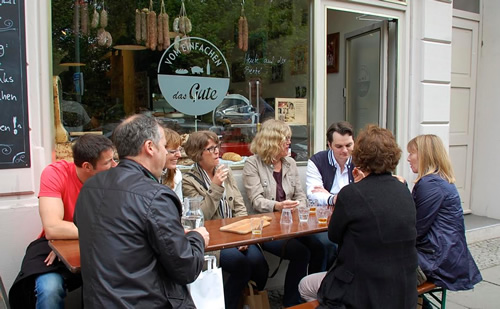
|
|
Sampling a platter
of regional cheeses and cold cuts at "Vom einfachen
das Gute."
|

|
|
Schneider's "Schokoladen
und Torten."
|
The tour starts at "Vom Fass" — an
oil, wine, and spirits shop, selling straight from the barrel — and
ends in a typical German Biergarten.
"Berlin Food Tours" also offers
other tours with a single focus on beer and currywurst,
coffee and cake, breweries, whiskey, chocolate, and absinthe.
Prenzlauer Berg
On my last day in Berlin, I decide to
explore and eat my way through my own Berliner neighborhood,
the trendy and upscale district of Prenzlauer Berg.
At Café Anna Blume, a renowned café-cum-flower
shop, I join local bohemians in the large covered outdoor
area where heaters and blankets keep us warm on this chilly
and rainy day. I order their specials served on an impressive
3-tiered breakfast stand: cheeses, cold meats, sun-dried
tomatoes, olives, fresh breads, fruits, and jams. A feast
for the eye and the palate.
Wandering along Prenzlauer Berg’s many
designer boutiques, art galleries, restaurants, cafes, and
specialty shops (don’t forget the highly original Polish
art poster shop "Pigasus" on Danzigerstrasse!)
in the pretty tree-lined streets around Kollwitz Platz,
I finally end up at the Kochhaus, dubbed as the
“walkable cookbook.” Merchandise here is not arranged according
to food, but to recipes, which means you can restrict your
shopping to just the ingredients and the quantities their
easy-to-make recipes require. An ideal concept for small
households, those with little storage room, and travelers
with access to a little kitchen.
I touch down for lunch at Café November,
a classical German restaurant with a cozy, low-key atmosphere,
where I am warmly greeted in spite of my heavily dripping
umbrella. Their smiles and heavenly homemade soup easily
make up for the lack of cooperation from the weather gods,
and their panna cotta with Himbeermus is
a worthy closure to the dazzling array of foods I have been
savoring in this hip and happening city.
Lies
Ouwerkerk is originally from Amsterdam,
The Netherlands, and currently lives in Montreal,
Canada. Previously a columnist for The Sherbrooke
Record, she is presently a freelance writer and
photographer for various travel magazines.
|
